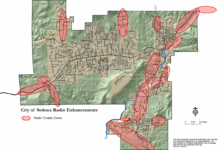Despite a bit of sticker shock, the Sedona City Council agreed that transit is something that needs to be addressed — sooner rather than later.
During a three-hour discussion on Wednesday, Oct. 23, council gave direction to staff to continue pursuing transit within the city limits and beyond after receiving a 485-page draft plan from LSC Transportation Consultants.
A.T. Stoddard, of LSC, was on hand to give the presentation and answer questions from council.
“What we’ve put together is responsive to the community input from the things we heard through all the surveys, stakeholder interviews, open houses and workshop,” he said. “So we wanted to put together a service plan based upon the things we heard as well as the quantitative estimates of the demand.”
There are four proposed phases for the project with a combined capital cost of $44 million. However, that does not include operational costs.
“I believe that moving into the future must include transit,” Councilwoman Jessica Williamson said. “It’s going to be expensive. All transit, regardless of where it is, is expensive. That’s not a reason not to do it. We can’t be afraid to do what needs to be done to make a vision a reality.”
The rest of the council was in favor of the plan but with a few reservations, the biggest of which came to funding. Speakers pointed out several times during the presentation that multiple funding sources — including the city, Yavapai and Coconino counties, private sector, state and federal agencies — will be needed in order to implement the service and to maintain it for years to come.
As a way to help oversee not only the funding but the overall project, council gave direction to staff to add a full-time city position in next year’s budget to do so.
The first phase of the plan begins with core routes connecting West Sedona, the Village of Oak Creek and Uptown. Shuttle service to local trailheads in the Sedona area would be included. While certain trailheads are being recommended, the actual trailheads will be determined through cooperative efforts with the U.S. Forest Service.
Phase I is the costliest at $23.5 million because it includes a $15 million operations and maintenance facility as well as $5 million for diesel buses for core routes. Staff noted if the city chose to go with electric buses, or even hybrid, that cost could rise substantially.
Phase II would add additional trailhead stops, which again would be decided upon by the USFS. This cost is estimated at $270,000.
Phase III will add destinations in Oak Creek Canyon. This includes an intercept parking lot in the VOC and more vehicles for the extended route to the VOC. This phase is estimated at $7 million.
The final phase will add express service from an intercept parking lot near VOC to Slide Rock State Park. This phase calls for a dozen additional vehicles for the Slide Rock route and a second VOC intercept parking lot, all of which carries a price tag of $13.5 million. If all four phases were to be implemented, it could take upwards of a decade to complete.
LSC conducted a resident survey, focus groups and individual stakeholder interviews with a separate survey for businesses. There were three community meetings, a council work session and visitor interviews.
In his presentation, Stoddard said the proposed transit routes will increase mobility for residents, visitors and employees. Benefits will include:
-Residents will have easier access to destinations like Uptown and trailheads.
-The visitor experience will be enhanced for all and those preferring a car-free vacation will have that option.
-Employees who live in Sedona and Cottonwood will have improved transportation to work.
-Transit will reduce drinking and driving.
-Persons with disabilities will have a new mobility option with the ADA demand-response service.
The proposed system will provide a frequent and convenient connection between destinations within Sedona, the Village of Oak Creek and Oak Creek Canyon. Services will run year-round with frequencies of every 15 to 30 minutes, he said.
A key benefit of the transit services will be the mitigation of parking requirements at key destinations including Uptown, trailheads and within Oak Creek Canyon. Combining the proposed transit service with enforced parking controls will reduce the negative impacts of uncontrolled parking on the canyon environment and Sedona neighborhoods.
“While transit alone cannot address Sedona’s growing traffic congestion, this plan will reduce traffic levels at key locations during peak time periods,” the report states. “Traffic volume at the Y could be reduced by 800 to 1,800 cars on peak days. Traffic on State Route 179 could be reduced by up to 1,300 cars on peak days.”






















